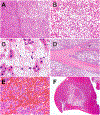Hepatocellular carcinoma: making sense of morphological heterogeneity, growth patterns, and subtypes
- PMID: 33387587
- PMCID: PMC9258523
- DOI: 10.1016/j.humpath.2020.12.009
Hepatocellular carcinoma: making sense of morphological heterogeneity, growth patterns, and subtypes
Abstract
Hepatocellular carcinomas are not a homogenous group of tumors but have multiple layers of heterogeneity. This heterogeneity has been studied for many years with the goal to individualize care for patients and has led to the identification of numerous hepatocellular carcinoma subtypes, defined by morphology and or molecular methods. This article reviews both gross and histological levels of heterogeneity within hepatocellular carcinoma, with a focus on histological findings, reviewing how different levels of histological heterogeneity are used as building blocks to construct morphological hepatocellular carcinoma subtypes. The current best practice for defining a morphological subtype is outlined. Then, the definition for thirteen distinct hepatocellular carcinoma subtypes is reviewed. For each of these subtypes, unresolved issues regarding their definitions are highlighted, including recommendations for these problematic areas. Finally, three methods for improving the research on hepatocellular carcinoma subtypes are proposed: (1) Use a systemic, rigorous approach for defining hepatocellular carcinoma subtypes (four-point model); (2) Once definitions for a subtype are established, it should be followed in research studies, as this common denominator enhances the ability to compare results between studies; and (3) Studies of subtypes will be more effective when morphological and molecular results are used in synergistic and iterative study designs where the results of one approach are used to refine and sharpen the results of the other. These and related efforts to better understand heterogeneity within hepatocellular carcinoma are the most promising avenue for improving patient care by individualizing patient care.
Keywords: Clear cell; Fibrolamellar; Growth patterns; Hepatocellular carcinoma; Heterogeneity; Steatohepatitic; Subtypes.
Copyright © 2020. Published by Elsevier Inc.
Conflict of interest statement
Conflicts of interest: The author declares no conflict of interest
Figures







References
-
- Torbenson M, Washington K. Pathology of liver disease: advances in the last 50years. Hum Pathol 2019. - PubMed
-
- Kojiro M Pathology of Hepatocellular Carcinoma. Replika Presss Pvt. Ltd.: India, 2006. 174pp.
-
- Yeh CN, Lee WC, Jeng LB, Chen MF. Pedunculated hepatocellular carcinoma: clinicopathologic study of 18 surgically resected cases. World J Surg 2002;26:1133–8. - PubMed
-
- Kitao A, Matsui O, Yoneda N, et al. Hepatocellular Carcinoma with beta-Catenin Mutation: Imaging and Pathologic Characteristics. Radiology 2015;275:708–17. - PubMed
Publication types
MeSH terms
Grants and funding
LinkOut - more resources
Full Text Sources
Medical

